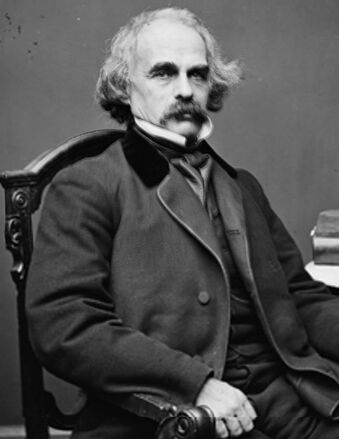Vertical Divider
|
Nathaniel Hawthorne (1804-1864) often used real Massachusetts locations as inspiration. The most famous example is probably The House of the Seven Gables, now a museum in Salem, MA, which inspired Hawthorne’s story of the same name. This enabled Hawthorne to present readers with a real historic landscape, adding authenticity to his fictional stories. The Scarlet Letter takes place in the seventeenth century, during the time when the Boston area was predominantly inhabited by Puritan colonists. King’s Chapel was actually built on the land the Puritans used for the first English burying ground in the city, and it is this piece of history that Hawthorne references three times in The Scarlet Letter. At the time his novel was set, the church would not yet have been built, but by its 1850 publication date, Hawthorne and his readers would have been very familiar with the church that had been on the site for over a century.
Much as the burial ground uses this church for easy identification today--it is called the King’s Chapel Burial Ground despite no association with the church--in Hawthorne’s novel, King’s Chapel also serves as a recognizable feature of Boston’s landscape. Listen to how Hawthorne roots his readers in early Boston in the conclusion of his book: “And, after many, many years, a new grave was delved, near an old and sunken one, in that burial-ground beside which King’s Chapel has since been built.” (chapter 24) Hawthorne expands upon the history of this location further by acknowledging not just what came after the burial ground—King’s Chapel’s church building—but also addresses how the land was used even earlier. A man named Isaac Johnson, one of the earliest Puritans to settle in Boston bought this plot of land for his home and farm. Before his death in 1630, he expressed a wish to be buried next to his home, and as many other colonists were soon buried there too, the space was reimagined as the first English burying ground in Boston. In the first chapter of The Scarlet Letter, Hawthorne draws upon this history to set the scene of his novel: “In accordance with this rule, it may safely be assumed that the forefathers of Boston had built the first prison-house somewhere in the vicinity of Cornhill, almost as seasonably as they marked out the first burial-ground, on Isaac Johnson’s lot, and round about his grave, which subsequently became the nucleus of all the congregated sepulchres in the old churchyard of King’s Chapel.” (Chapter 1) Through his writing Nathaniel Hawthorne provides us with this excellent introduction to the historic landscape and society of early Boston. |


